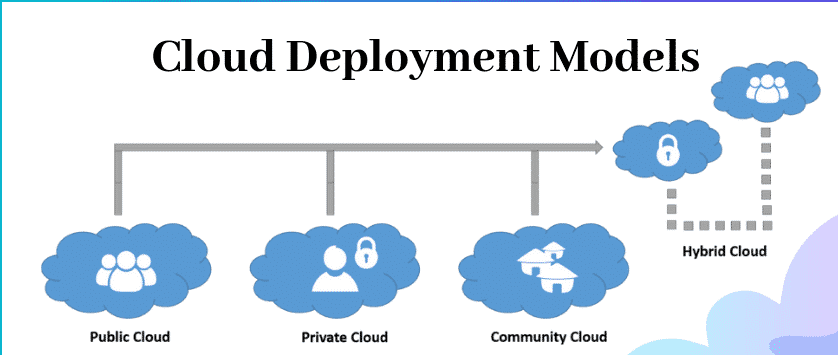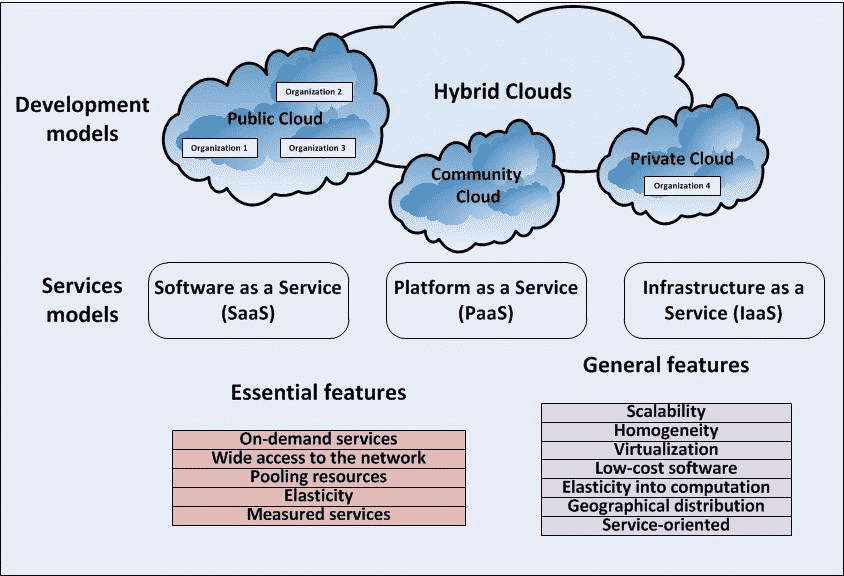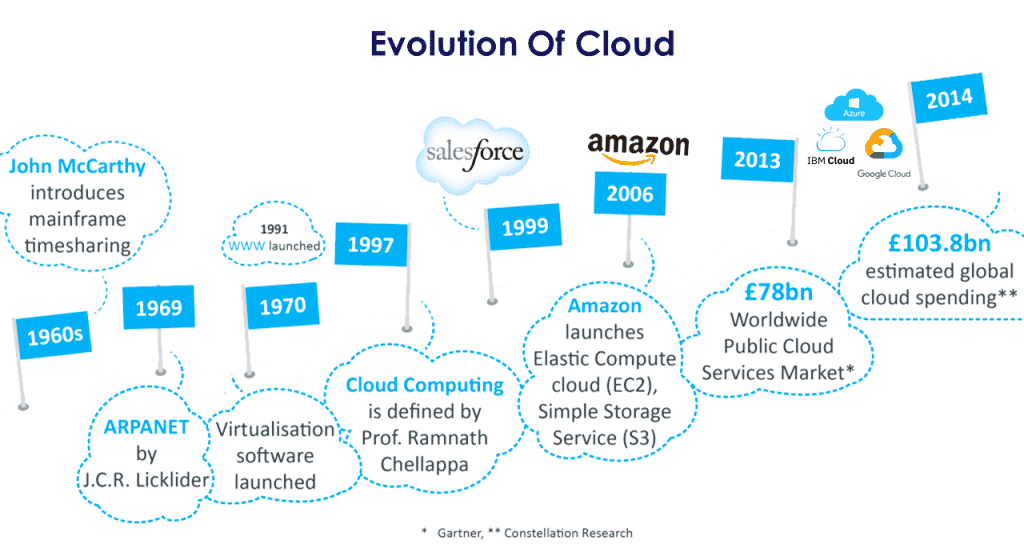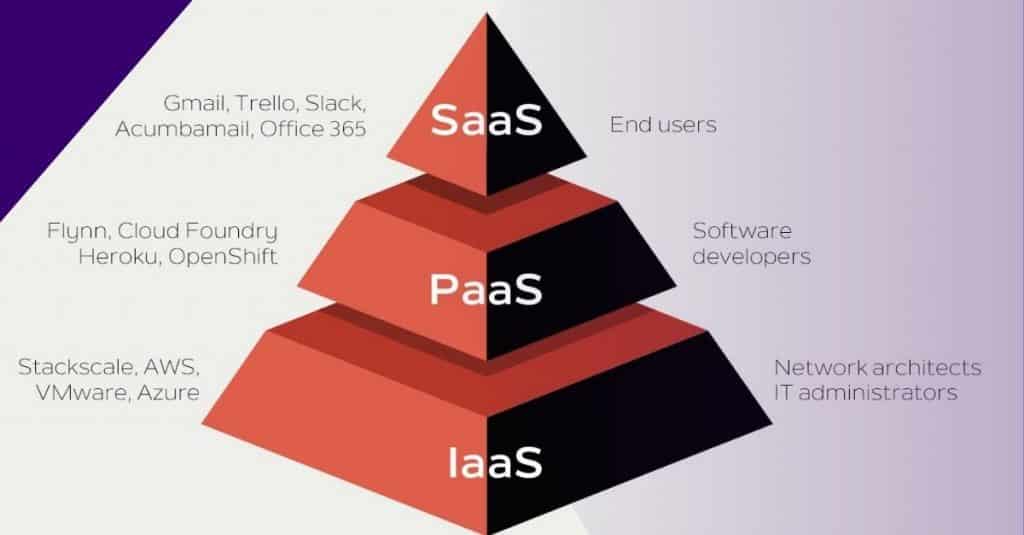Top 10 AI Marketing Apps & Benefits – Power of Artificial Intelligence
2 years agoWhat is the emergence of Cloud Computing in Nepal?
3 years ago -

“Cloud computing is a family of distributed computing system”
Adoption of cloud computing in Nepal
History of cloud computing in Nepal
Cloud computing, sometimes referred to simply as “cloud,” is the use of computing resources — servers, database management, data storage, networking, software applications, and special capabilities such as blockchain and Artificial Intelligence (AI) — over the internet, as opposed to owning and operating those resources yourself, on-premises.
Distributed computing can simply be defined as sharing of tasks by different computers which may be in different parts of the globe. The distributed system which is used here must be in networked computers so that communication and coordination of the tasks are handled smoothly. The main goal of distributed computing is to connect the users with the resources thereby maximizing the performance in a cost-effective way. It is also structured in a way that in case one of the components fails, the system goes on and the desired results are reached. Distributed computing is the use of distributed systems to solve single large problems by distributing tasks to single computers in the distributing systems.
On the other hand, Cloud Computing is the use of network-hosted servers to do several tasks like storage, process, and management of data. Here we will give an in-depth analysis of the two. Cloud computing has taken over the IT industry in the recent past. This is due to the fact that it is cheaper and easier to get services from the cloud. The cloud enables its users to choose how they will get and deliver IT services.
Cloud computing means you can store and access data from the internet rather than the traditional computer hard disk storage. This means you can access the data you have stored in the cloud anywhere anytime. The cloud will help you access the storage, servers, databases, and multiple application services all in one place, the internet.
Netflix is one example of an organization using the cloud. By running on AWS, it provided billions of hours of service to customers around the globe. Users can order their products/services from almost anywhere in the world, using PCs, tablets, or mobile devices.
Deployment models of Cloud Computing
There are four cloud deployment models: public, private, community, and hybrid. Each deployment model is defined according to where the infrastructure for the environment is located.
Public Cloud – the infrastructure is made available to the general public or a large industry group and is owned by the organization selling cloud services.
Private Cloud – the infrastructure is operated solely for an organization.
Community Cloud – the infrastructure is shared by several organizations and supports a community that has shared concerns.
Hybrid Cloud – composition of two or more clouds (public, private, or community) as unique entities but bound by standardized technology that enables data and application portability.

Challenges for Cloud Computing
- Availability of service; what happens when the service provider cannot deliver?
- Diversity of services, data organization, user interfaces available at different service providers limit user mobility; once a customer is hooked to one provider it is hard to move to another. Standardization efforts at NIST!
- Data confidentiality and auditability, a serious problem. – Data transfer bottleneck; many applications are data-intensive.
More challenges
Performance unpredictability, one of the consequences of resource sharing.
- How to use resource virtualization and performance isolation for QoS guarantees?
- How to support elasticity, the ability to scale up and down quickly?
- Resource management; are self-organization and self-management the solution?
- Security and confidentiality; major concerns.
- Addressing these challenges provides good research opportunities!!
The IT sector is an emerging area in Nepal. The Government of Nepal has identified IT and business process outsourcing (BPO) as one of the 5 priority potential export service sectors in the Nepal Trade Integration Strategy (NTIS) 2010. IT has the potential to generate high growth, investment, and significant profits in the coming years and is expected to be one of the most significant growth contributors to the Nepali economy. Business documents and data are very much important for every size of business. As we all know that world is progressing in the field of technology. We also accept that technology has improved almost everything which we use in our daily life and it also has provided us the strong fencing to secure our most important data and documents to get from loss.
Cloud computing is one of the most advanced and secure systems to protect the data and information in the cloud. It was very much common in past days to store data and information through a manual process or on the hard drive of the computer. It is also very much difficult to recover the complete data and information once it gets lost from us. Now cloud computing is the safest and most advanced option to get secure the data and information related to the business terms without any fear. There are many trusted cloud solutions providers we will surely get around to whom we can get the best cloud computing services to store our data and information securely on the cloud.
5 benefits of cloud computing

Broad Network access: First, “broad network access.” Access to resources in the cloud is available over multiple device types. This not only includes the most common devices (laptops, workstations, etc.) but also includes mobile phones, thin clients, and so on. Contrast “broad network access” with access to compute and network resources during the mainframe era. Computing resources forty years ago were scarce and costly. Usage was limited based on priority and criticality of workloads in order to conserve those resources. Similarly, network resources were also scarce. Internet Protocol (IP) based networks were not in prevalent usage back then, consequently high-bandwidth, low-latency networks did not exist. Overtime costs associated with the network (like costs associated with computing and storage) have decreased due to manufacturing scalability and commoditization of associated technologies.
Rapid elasticity: Elastic computing is critical to cost reductions and time to market (TTM). Indeed, the notion of elastic resources in the IT supply chain is so desirable that Amazon named their cloud platform “Elastic Compute Cloud” (“EC2”). In terms of FTE costs, as I will demonstrate in later chapters, the OPEX associated with provisioning (moves, adds, and changes or MAC) in the IT supply chain are typically the most significant portion of the charges related to application deployment.
Measured service: It indicates that usage of these “pooled resources” is monitored and reported to the consumer, providing visibility and transparency to consumption rates and costs. Usage monitoring, for the purposes of the chargeback (or merely for cross-departmental reporting and budgeting), has been a long-time requirement of IT stakeholders — another holy grail it seems — but building such a system is usually not a core competency of most IT departments.
On-demand self-service: It is a key — some say the primary — characteristic of the cloud. If we think of IT as a complex supply chain with the application and the end-user at the tail end of the chain, the ability to self-provision resources in typical IT environments fundamentally disrupts the workflow and processes that have evolved as a function of corporate IT over the last several decades. This includes workflow related to the procurement of storage, servers, network nodes, software licenses, and so on.
Resource pooling: It is a fundamental premise of scalability in the cloud. Without pooled computing, networks, and storage a service provider must provision across multiple “silos” or discrete, independent resources with few or no interconnections. Multi-tenant environments, where multiple customers share adjacent resources in the cloud with their peers, are the basis of public cloud infrastructures. With multi-tenancy, there is an inherent increase in operational expenditures, which can be mitigated by certain hardware configurations and software solutions, such as application and server profiles.
History of Cloud Computing

- The concept evolved in 1950(IBM) called RJE (Remote Job Entry Process).
- In 2006 Amazon provided the First public cloud AWS(Amazon Web Service).
- Later Hotmail, Google, started mail service based on the cloud.
- Managed cloud services are started by various cloud service-providing vendors.
- 2010 Enterprize started to migrate their data to the cloud.
- The trend of cloud migration is increasing day by day.
Cloud: Datacenters
Datacenter: It is a collection of servers where the application is placed and is accessed via the internet. Distributed servers: Often servers are in geographically different places, but server acts as if they are working next to each other.
Central Server: It Administers the system such as monitoring traffic, client demands to ensure everything runs smoothly. It uses a special type of software called Middleware. Middleware allows the computer to communicate with each other.
Cloud: Models
SaaS(Software as a service): Required software, Operating system & network is provided.
PaaS(Platform as service): Operating system and network are provided.
IaaS(Infrastructure as a service): just Network is provided.

- Cloud computing services have huge opportunities in the Nepal market due to a large number of Small and Medium businesses (SMBs).
- Most of the leading companies are already on the cloud.
- E-Governance can be implemented on rural areas using cloud.
- Distance learning to remote areas and schools.
- The benefit to SME and corporate house. Increasing trend of outsourcing jobs.
Where Can I Access Cloud Computing?
There are many cloud computing services available to individual users, but the “big three” are:
- Amazon Web Services (AWS)
- Google Cloud Platform (GCP)
- Microsoft Azure
The service you choose will depend on:
- The scale of your business
- Your business structure
- How much of the work you want to outsource
Adoption of Cloud Computing in Nepal
In Nepal, most Datacenters (DCS) give oversaw service, collocation, network uphold, and cloud services. The cloud service suppliers in Nepal give just a restricted sort of cloud services with a restricted alternative. Practically neither of any organizations gives an expert level full cloud services with SLA. The rundown given below portrays the DCs and cloud service suppliers in Nepal: Government Integrated Data Center (GIDC) is an international standard Government’s DC operated through National Information Technology Center (NITC). GIDC began offering types of assistance to just government associations in 2009. At first, GIDC was giving just Webhosting, email facilitating & worker co-area services. At present, GIDC is demonstrating cloud services to not many government associations. The kind of cloud services given by GIDC is generally IaaS & PaaS. Since all the services given by GIDC are liberated from cost, so there is no reasonable SLA among customers & GIDC. GIDC gives cloud services through a single DC & they don’t have a DR center yet. They have focused to manufacture their own DR center in Hetauda inside 2016. Data Hub is an international standard web DC in Nepal. It offers types of assistance like co-area services, data & organization security, catastrophe recuperation. It is situated in Thapathali, Kathmandu (Sharma, June 2017).
Adoption of Cloud Computing in Banking
Role of IT in Banking
Some Factors that motivate us to implement cloud computing in Nepal are:
- Increase in the flexibility of storage
The first and the most important benefit you will get from cloud computing services is to increase the flexibility of the storage. If we think we have a lot of different files and documents to get secure you can increase the storage limit according to our needs and desire.
- Easily recover the data
Cloud computing will allow us to easily recover the data and information anytime we want. If we want to repair your system or want to change our system, we can back up your data to cloud storage. After completing your task, we can easily get the secure backup of your data on your system respectively
- Easy access to the data
when we have the idea that your data is securely placed in the cloud, we can easily get access anytime we want. Modern technology has provided us the chance to perform our tasks sufficiently and authentically. We can surely perform a better task if you have much time to do it.
- Data secure and protected
Modern technology has provided the best solution to store the data and information on cloud services and it is a much secure and authentic service that will strongly make a fence around our data that cannot get accessed by an anonymous person. It will also get secure from any type of malware and theft as well
- No maintenance required
Cloud computing service is secure for any type of maintenance. We just have to believe that our cloud storage data will be safe and secure from any type of harmful effects. We just have to pay for the storage charges to the companies and it will always keep the data and information security.
- Easy to share the information
Through, cloud service, we can easily share our data through the secure network to anyone we want. There are many possibilities to share our data without any fear to anyone by sharing the relevant link to the concerned person. It will save the data from any type of malware and nobody can enter our privacy lounge without authentication.
DataHub has almost a decade of experience providing co-location, hosting, and premium data-center services. Trusted by leading Nepali brands like Nepal Life, eSewa, Global IME Bank, Khalti, Subisu, Fone-pay, merojob, Vianet, and many other trusted companies
you can get the “Cloud Computing Training in Nepal” at Broadway Infosys.



![[2025 Updated] Top 10 Digital Marketing Agencies in Nepal Ranked!](https://mysticrubs.com/wp-content/uploads/2022/05/top-10-digital-marketing-company-in-nepal.png)








